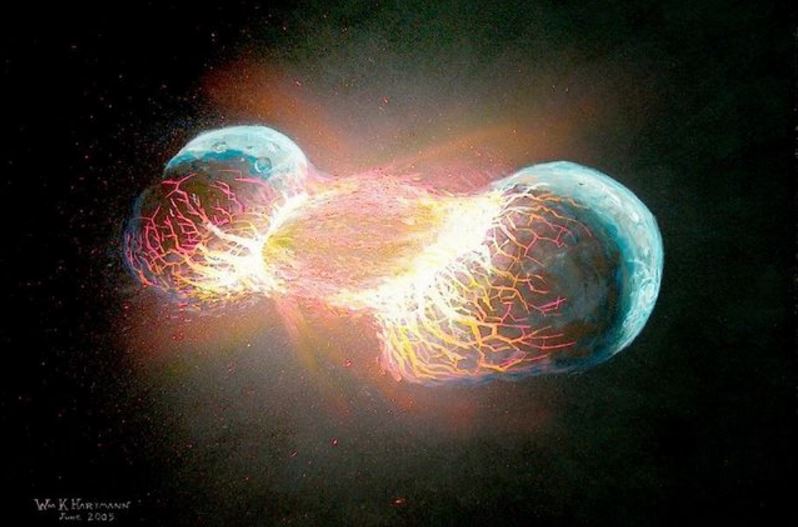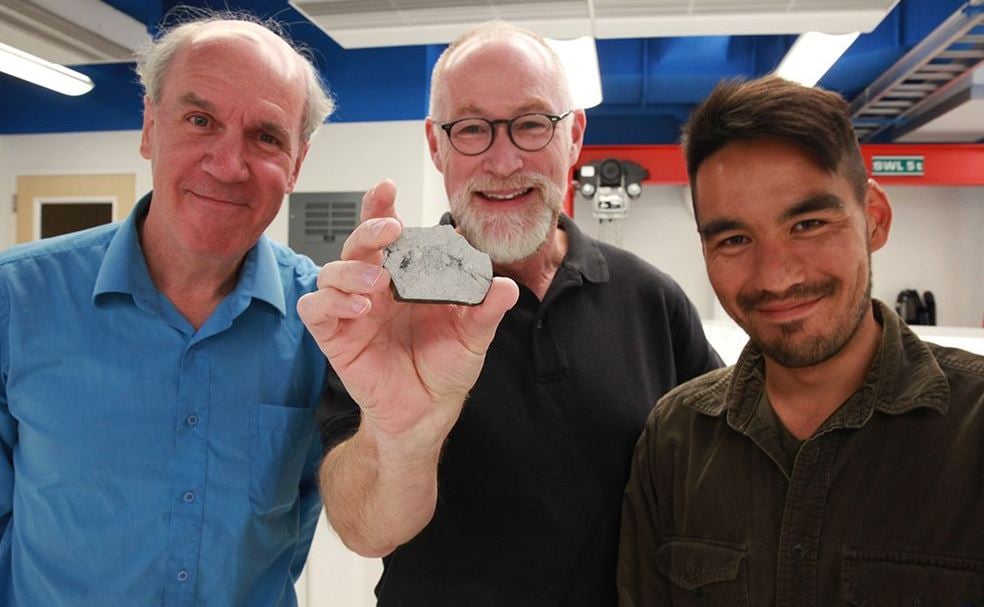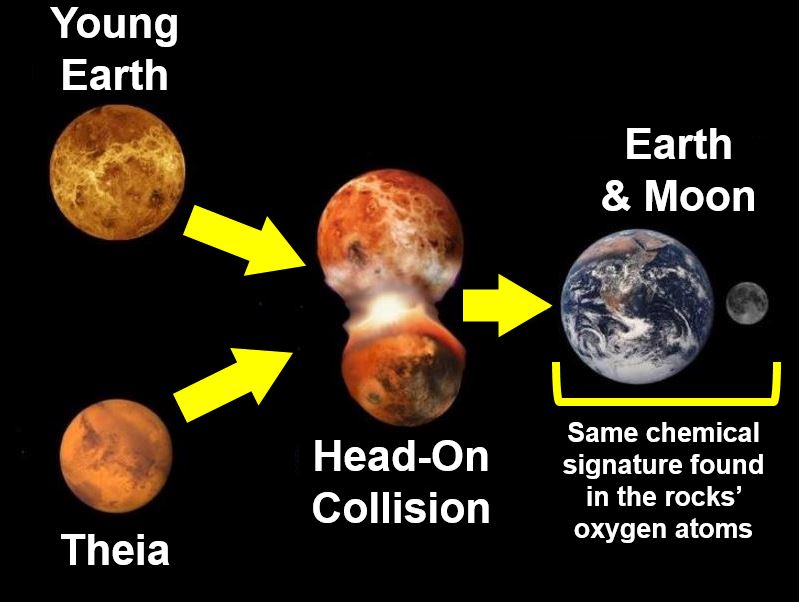The Earth is made of two planets and so is the Moon – their current compositions are the result of a mega head-on collision between Earth and a ‘planetary embryo’ known as Theia, about 100 million years after our planet was formed, say scientists from the University of California Los Angeles, the University of Bayreuth in Germany, and L’Université de Nice–Sophia Antipolis in France.
While scientists already knew there had been a high-speed collision nearly 4.5 billion years ago, everybody thought that Theia (pronounced: THAY-eh) came in at an angle of 45 degrees or more – i.e. there was a powerful side swipe.
According to this latest study,, which has been reported in the journal Science (citation below), new evidence has emerged which suggests there was probably a head-on assault, like two trains that crash into each other head-to-head.
 There was a head-on collision between Earth and Theia, hence Earth and Moon rocks have similar chemical compositions. (Image: ucla.edu)
There was a head-on collision between Earth and Theia, hence Earth and Moon rocks have similar chemical compositions. (Image: ucla.edu)
The scientists analyzed seven rocks that had been brought back to Earth from the moon by three Apollo missions (12, 15 & 17), as well as six volcanic rocks from the Earth’s mantle – one from Arizona and five from Hawaii.
Chemical signature of Earth & Moon rocks
A chemical signature found in the rocks’ oxygen atoms was the key to reconstructing the colossal impact. Ninety percent of the rocks’ volume and 50% of their weight consisted of oxygen.
The vast majority (over 99.9%) of the Earth’s oxygen is O-16 (16O), so called because each atom’s nucleus contains 8 neutrons and 8 protons.
However, there are also tiny quantities of heavier oxygen isotopes: O-17, which has an additional neutron, and 0-18, which has two extra neutrons.
Mars, Earth and other planets in our solar system each has a unique O-17 to O-16 ratio, i.e. each one has its own ‘fingerprint’.
Two years ago, a team of scientists form Germany reported in Science that the Moon, which also has its own oxygen isotope fingerprint, is different from Earth’s. According to this latest study, that is not the case.
Earth’s and Moon’s isotope fingerprint the same
Lead author, Edward Young, professor of *geochemistry and *cosmochemistry at UCLA’s Earth Planetary and Space Sciences Faculty, said:
“We don’t see any difference between the Earth’s and the Moon’s oxygen isotopes; they’re indistinguishable.”
*Geochemistry is the study of the chemical composition of the earth and its rocks and minerals. *Cosmochemistry (chemical cosmology) is the study of the chemical composition of matter in the universe and the processes that led to those compositions.
 Paul Warren (left), Edward Young holding a sample of a rock from the moon, and Issaku Kohl. (Image: ucla.edu)
Paul Warren (left), Edward Young holding a sample of a rock from the moon, and Issaku Kohl. (Image: ucla.edu)
Prof. Young and colleagues used cutting edge technology and techniques to make extraordinarily precise and careful measurements, and confirmed them with UCLA’s new mass spectrometer (a device for separating isotopes, molecules, and molecular fragments according to mass).
The fact that the oxygen in the Earth and Moon rocks share the same chemical signatures is very telling, Prof. Young said. If Theia and Earth had collided in a glancing side blow, most of the moon would have consisted mainly of Theia, and the Moon and Earth would have different oxygen isotopes.
Identical isotope fingerprint only possible after head-on collision
With a head-on-collision, the explosion would have included all the mass of both planets blowing up into tiny bits, which would then come together as two celestial bodies all mixed up, with the Moon and the Earth sharing virtually identical chemical compositions.
 Earth and Moon rocks have the same chemical signature. This is only possible if Theia crashed into the Earth head-on. (Image adapted from static.nautil.us)
Earth and Moon rocks have the same chemical signature. This is only possible if Theia crashed into the Earth head-on. (Image adapted from static.nautil.us)
Prof. Young said:
“Theia was thoroughly mixed into both the Earth and the moon, and evenly dispersed between them. This explains why we don’t see a different signature of Theia in the moon versus the Earth.”
Theia, which did not survive the collision – except that now it makes up significant parts of the Moon and Earth – was growing and would likely have become a planet if it had not crashed into Earth, Prof. Young said.
Prof. Young, along with a number of other scientists believe Theia was about the same size as the Earth, while others think it was probably about the size of Mars (smaller than Earth).
Did the collision rid Earth of its water?
When Earth and Theia crashed into Each other, did the early Earth lose any water it might have had?
After the collision – maybe several tens of millions of years later – small asteroids probably hit the Earth. Some of these asteroids may have been rich in water, Prof. Young said. Back then, collisions between growing celestial bodies occurred very frequently, he said, although Mars appears to have been spared mega impacts.
Matija Cuk, who today works as a research scientist at the SETI Institute, and Prof. Sarah T. Stewart, who teaches at UCDavis’ Earth and Planetary Sciences faculty, initially proposed the head-on collision in 2012. Also in 2012, Robin C. Canup, Associate Vice President – R&D – at the Southwest Research Institute’s Space Science & Engineering Division, suggested a head-on collision separately.
Citation: “Oxygen isotopic evidence for vigorous mixing during the Moon-forming giant impact,” Edward D. Young, Issaku E. Kohl, Paul H. Warren, David C. Rubie, Seth A. Jacobson & Alessandro Morbidelli. Science. 29 Jan 2016: Vol. 351, Issue 6272, pp. 493-496. DOI: 10.1126/science.aad0525.
Video – Moon formation resulting from xxxx
This is a simulation of how the Moon was formed if Earth had been struck by Theia with a powerful side swipe. After this latest study (described above), scientists believe it was a head-on collision.

